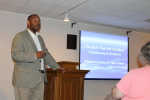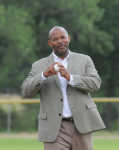Baseball author, historian shares stories of Monarchs, early town baseball

Nevada Daily Mail
A lifelong passion for sports, in particular baseball, coupled with a love of stories and history, led Phil Dixon to Nevada.
Dixon, an author of nine published works and soon to be a 10th, all of which focus on history and either baseball or boxing, addressed members of the Vernon County Historical Society.

His Nevada stop was part of his 90-city tour focusing on telling and retracing the steps of one of the most famous Negro League teams, the Kansas City Monarchs.
The Monarchs traveled across this part of the country, in particular the four-state area, "barnstorming," playing games against town teams, professional teams, and other famous traveling squads like the House of David and the Oklahoma Indians, in addition to their Negro League games.
Dixon, during his years working with the Kansas City Royals in their public relations department, became interested in finding out more about these early players, and began his research, which has taken him across the country.
A lifelong baseball fan, Dixon told the audience Sunday at the Bushwhacker Museum that he estimated he had collected 100,000 baseball cards by the time he was 19.
It was a natural then that took a position with the baseball Royals in the American League, then later joined with four other men, including long-time Negro League star Buck O'Neil, in founding the Negro Leagues Baseball Museum, where Dixon remains a member of the Advisory Board.
"Buck was the oldest and I was the youngest," noted Dixon of the five co-founders.
Dixon's interest in learning more about the players of this earlier era was also fueled by another of the Monarchs' famed players, Eddie Dwight, who lived nearby.
As Dixon grew more interested, he interviewed more players around the region.
While he admitted, like most fans, loving the statistical part of the game, it was unearthing the stories about the men behind those statistics that made the game that much more fascinating.
"It was always the stories that attracted me to baseball," he said.
And the more he learned, the more he wanted to learn and the more he wanted to share what he had learned.
Discovering that the Monarchs played in some 90 cities across this part of the country, Dixon decided to follow their path and share their stories in these same towns.
He estimated that Nevada was somewhere in the 30s on his list of tour stops, adding, "it's hard to keep track," of the schedule that sees him on the road virtually every weekend, sometimes in multiple towns the same day.
He showed a map of that era and roads that were traversed, many of which he follows as he journeys to the same towns where the Monarchs performed their exhibition games.
Dixon highlighted the Monarchs travels to this area, nothing they came to nearby Rich Hill and played Aug. 23, 1923, then played in Nevada later that year, on Oct. 5.
The game in Nevada was against a professional team, said Dixon, as the fall was the time when the major league season had just concluded and the players would do exhibition games to make money.
In Nevada, the Monarchs faced the Wichita team of the Western League.
The Nevada game was one of a series scheduled in the area with Wichita, which started in Parsons, Kan., went to Pittsburg, and Fort Scott, then came to Nevada and finally ended in Kansas City.
The Monarchs would later play in Nevada again, for the last time, coming in 1954.
Recalling the beginnings of the Monarchs in the 1920s in Kansas City, Dixon noted that "when they first started as a team, they didn't know what the future held," but they did determine that they would go to cities "that they could get to in a day.
"They weren't allowed to stay in the hotels or eat in the restaurants so they needed to be close to home," said Dixon.
"This was the golden age of town baseball."
At that time, most every town of any size had an organized baseball team. So it was natural for the Monarchs to traverse the country playing games.
"The railroads had built up a lot of these cities."
This was also when the Negro Leagues formed, with a National League, a Southern League, and later an American League, offering players the opportunity to play baseball at a time when the country was segregated.
The Negro Leagues continued in existence until the mid-1960s.
"It had served its purpose and there wasn't a need anymore," said Dixon of the Negro Leagues demise.
"The Major Leagues were integrated, town baseball had declined and it just wasn't profitable."
While the Leagues served as a way for players to compete against other organized teams, it was often the travel games to towns throughout the region that proved to be the most financially rewarding to the players, said Dixon.
The heyday of the barnstorming era for teams like the Monarchs came in the 1920s and '30s and continued until the mid-1950s against the town teams.
When the Monarchs came to town, they would get 65 percent of the gate.
"They usually drew the largest crowd."
Because the team kept meticulous records, Dixon showed those in attendance the Monarchs' share ranged from $1,034 in Topeka to $166 in Rich Hill during one such year of playing exhibitions.
"The teams and players made more money playing town teams.
"The average player in the 1920s made $200-400 a month," said Dixon.
Among their opponents were the Oklahoma Indians, a team that was managed in 1933 by Jim Thorpe, who was named the Greatest Athlete of the 20th century. Thorpe, a Sauk and Fox Indian, won the pentathlon and decathlon at the 1912 Olympics, and starred in collegiate and professional football and professional baseball and basketball.
Thorpe inserted himself in the game against the Monarchs as a pinch-hitter and had a double. The Indians prevailed 9-3, one of the very few teams to defeat the Monarchs.
The Israelite House of David, a team based out of Benton Harbor, Mich., and organized through their religious society, played the Monarchs in 1931.
House of David, whose players' signature look featured long hair and beards, had their own famous member, with Grover Cleveland Alexander as their manager. Alexander would later earn his own place in the Hall of Fame after a career that included 373 wins, 2,198 strikeouts, and 90 shutouts, the latter a record that still stands in major league baseball.
As part of his contract, he had to pitch every night, which usually consisted of two innings, said Dixon.
Yet the Monarchs were able to prevail in this contest, 8-0.
Because of the team's extensive travel to play these various town and traveling teams, the Monarchs came up with several key innovations.
"In 1920s, every team traveled by train," said Dixon. "But the Monarchs changed to bus transportation in 1926, something no team had done before."
J.L. Wilkinson pioneered that change, said Dixon. Wilkinson, a white businessman, was the founder and owner of the Monarchs, and was the only white owner in the Negro Leagues.
He directed the Monarchs from the team's entry in the Negro National League in its inaugural season, 1920, through the 1947 season.
Wilkinson also pioneered something that the major leagues initially scoffed at, night baseball.
Despite being told it would never catch on, Dixon said that in 1930, Wilkinson devised a portable lighting system so the Monarchs could play at a time when more people could attend.
Wilkinson also came up with an "All-Nation" team concept even earlier, in 1911, with players from a variety of backgrounds, including Negro, Indian, Cuban, and Italian backgrounds, among others.
Jose Mendez was the first Cuban manager, in 1914.
Dixon touched on a handful of Monarchs, including catcher and utility player Carroll Ray "Dink" Mothell, infielder-outfielder Eddie Dwight, left-handed pitcher Andy Cooper and outfielder-pitcher Wilber "Bullet" Rogan.
Mothell, known for his ability to play every position, was the catcher for Cooper and Rogan.
Dwight spent the bulk of his 13 seasons in the Leagues with the Monarchs. His son became the first black American selected by NASA for astronaut training.
Cooper, who was inducted into the National Baseball Hall of Fame, won over 170 games on the mound, pitched in the Negro Leagues All-Star game at age 40, and went 17 innings on the mound in the Negro League playoffs in 1937.
Rogan may have been not only the best Monarch but also the best baseball player ever, said Dixon.
"He won over 400 games as a pitcher, hit over 400 home runs, and had a .343 batting average. He was the manager of the Monarchs in 1929 when the team went 134-14. And he drove the bus," Dixon added.
Rogan is the subject of one of Dixon's six books on the Negro Leagues.
Dixon's recounting of Rogan, Cooper, Wilkinson and the Monarchs will continue, he said, in his next stops on his tour, which will take him to Indianapolis, Bloomington, Ind., and Nashville, Tenn.
More about the Kansas City Monarchs
* Negro League champions 1923, 1925
* Negro World Champions 1924, 1929
* The Monarchs reportedly only lost three times in over 400 exhibitions
* From 1930-36, the Monarchs won over 800 games
* Games took place as far away as Canada, Mexico, Oregon and Washington
* Other standout players for the Monarchs included Hall of Famers "Cool" Papa Bell, Satchel Paige, Ernie Banks
* Other prominent Negro League players include Hall of Famers Monte Irvin, Josh Gibson, Hank Aaron, Roy Campanella, Buck Leonard, and Willie Mays.
